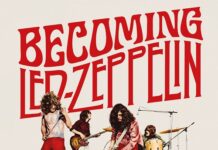By Shawn Perry
As you may know, listening to records is an involving process. Whereas any dope can slap in a cassette or plop on a CD, records require special handling and care, placement and synchronization skills. Most of all, you have to pay attention because when the record ends — almost always sooner than you think — you have to be prepared to rescue your stylus and your sanity from the end-of-the record crunch. Whew! That was a close one.
But think about it if you will: while paying attention, one might grow to actually appreciate what lies between the grooves that much more. We are such a hurried society, that we often think we can portabalize anything — physical, mental, whimsical — and take it on the road. CDs and cassettes are popular because they lend themselves to these very concepts. You can’t take your records to the beach or on an airplane, but then again it’s questionable as to whether or not these places are ideal environments for music. With records, you simply have to set aside an evening. Not a bad thing at all.
Besides the flipping, cleaning and variances of turntable speed that has to be monitored, there’s the album cover. Some of it is plain and uncomplicated, others make the most of it with extensive art work, allegories, photographs, messages, gateways to other dimensions. There are coffee table books that are full of album cover art. I’ve yet to see any books on CD or cassette art. Cassettes are minuscule no matter how you look at it. They’re just too compact to make the commitment. On the other hand, some record companies and specialty houses have tried to re-invent album cover art within the CD format. DCC goes to such lengths as utilizing original sources who worked on the original albums. In 1994, Virgin released a nice set of Stones CDs, recreating such early 70’s gimmicks as the zipper on Sticky Fingers. Aside from such details and flourishes added to reissues, not much can be said for new releases. Either the creativity has dried up or they’re saving everything for the box set.
When you hold an album in your hands — it takes two if you want to do it properly — you are holding history. Okay, they still make records, and more people are buying vinyl than they have since the beginning of the decade, but there’s still a good 50 years of music on vinyl that will never make it to CD. They may think they have it licked, but it’s an impossible task from the most logical standpoint. There will always be missing pieces. Economically, it probably doesn’t make much sense. That’s why they can’t rebuild Rome either.
Let’s Get Progressive
Which leads me to four albums that I recently spent a couple of evenings removing from their fragile sleeves, spinning, recording and replacing back into their crumbling jackets. Oh yeah, record records so I won’t have to hassle playing them any more than necessary. I especially enjoy tapes that capture all the snap, crackle and pop — it sort of brings you down to earth. Anyway, these four albums were in pretty good shape. They are four obscure albums by English progressive rock bands of the 70’s.
The first one is Camel’s Moonmadness. This album exemplifies the state of progressive rock in the late 70’s — aimless, pretentious, commercially dry yet highly listenable. Camel ranks as one of a string of bands who rolled in on the heels of ELP, Yes, Genesis and to a large extent, lesser known trailblazers like Gentle Giant and Strawbs. Unfortunately, Camel, U.K., Starcastle and other prog rock bands of the time got lost in the trample of punk and more directly, their radio-friendly American counterparts like Styx and Kansas.
Speaking of Yes, the next two albums came from former members. Flash In The Can was issued in 1972 by a group called Flash with original Yes guitarist Peter Banks. The album has a very “Yes” feel to it, with bits and pieces of this and that thrown in for good measure. The opening track, “Lifetime” is a tasty rocker driven by Bank’s ambitious guitar style and Ray Bennett’s irrepressible homage to Chris Squire. Vocalist Colin Carter wavers between Jon Anderson, Ian Anderson and probably Hans Christian Anderson on a bad day. The second album is by Badger, lead by Tony Kaye, who by last count was sidelined in Yes — again — by Rick Wakeman. The album, One Live Badger, is, well, a live album — live, in fact, from the famous Rainbow Theater in London. Nothing too spectacular here, although the musicianship is pretty solid. The Yes affiliation is present throughout, which clearly backs my theory that Kaye has always been like a displaced wanderer of the Yes paradigm and is forever on their payroll.
The last album is by a couple of former King Crimson members, which in 1971, wasn’t a hard thing to find. Just about every progressive rock album of the period had a former King Crimson member. These two — Ian McDonald and Peter Giles — were a couple of the original players on Crimson’s landmark debut album, In The Court Of The Crimson King, which could mean only one thing: give ’em the green light cause they’re liable to do anything. So McDonald and Giles features people like Steve Winwood to sort of give the album some boasted credibility, and it went off on a few tangents that even Robert Fripp might have had trouble understanding. the second side is a single piece called “Birdman” that features another former Crimson cohort, lyricist Peter Sinfield. It’s hard to tell if Sinfield ever got his due share until he started penning words for ELP. In “Birdman,” he is sill trying to find his voice. Still, an interesting experiment, and a nice notch in McDonald’s belt which would take him on to bigger and better things with…Foreigner.




















